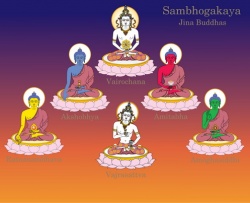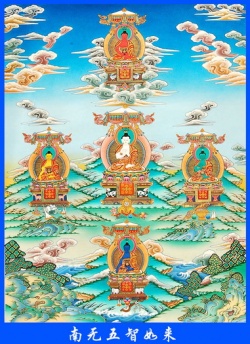Five Dhyani Buddhas
In Vajrayana Buddhism, the Five Dhyani Buddhas (Chinese: 金刚界五智如来 / 五方佛), also known as the Five Wisdom Tathāgatas (Chinese: 五智如来; pinyin: Wǔzhì Rúlái), the Five Great Buddhas and the Five Jinas (Sanskrit for "conqueror" or "victor"), are representations of the five qualities of The Buddha.
The term "dhyani-Buddha" is first recorded in English by the British Resident in Nepal, Brian Hodgson, in the early 19th century, and is unattested in any surviving traditional primary sources.
These five Buddhas are a common subject of Vajrayana mandalas. These five Buddhas are the primary object of worship and Meditation in Shingon Buddhism, a school of Vajarayana Buddhism founded in Japan by Kūkai.
Origination
The Five Wisdom Buddhas are a later development, based on the Yogācāra elaboration of concepts concerning the jñāna of the Buddhas, of the Trikaya (In Sanskrit, Tri is "three", kaya is "Body") theory, which posits three "bodies" of The Buddha.
The Wisdom Buddhas are all aspects of the Dharmakaya or "Truth-Body", which embodies the principle of Enlightenment.
Initially two Buddhas appeared which represented Wisdom and Compassion - they were, respectively, Akṣobhya and Amitābha.
A further distinction embodied the aspects of Power, or activity, and the aspect of Beauty, or spiritual riches.
In the Sutra of Golden Light (an early Mahayana Sutra) the figures are named Dundubishvara, and Ratnaketu, but over time their names changed to become Amoghasiddhi, and Ratnasaṃbhava.
The central figure came to be called Vairocana.
When these Buddhas are represented in mandalas, they may not always have the same colour or be related to the same directions. In particular, Akṣobhya and Vairocana may be switched.
When represented in a Vairocana Mandala, the Buddhas are arranged like this:
| Amoghasiddhi
(north) |
||
| Amitabha
(West) |
Vairocana | Akshobhya
(East) |
| Ratnasambhava
(South) |
Names
Names in other languages:
Qualities
There is an expansive number of associations with each element of the Mandala, so that the Mandala becomes a cipher and mnemonic visual Thinking instrument and concept map; a vehicle for understanding and decoding the whole of the Dharma.
Some of the associations include:
| Family/Buddha | Colour ← Element → Symbolism | Cardinality → Wisdom → Attachments → Gestures | Means → Maladaptation to Stress | Season |
|---|---|---|---|---|
| Buddha/Vairocana | white ← space → wheel | center → all accommodating → form → Teaching the Dharma | Turning the Wheel of Dharma → Ignorance | n/a |
| Vajra/Akshobhya | blue ← water → scepter, Vajra | east → nondualist → consciousness → humility | protect, destroy → Anger, hate | spring |
| Padma/Amitābha | red ← fire → lotus | west → inquisitive → Perception → Meditation | magnetize, subjugate → selfishness | summer |
| Ratna/Ratnasambhava | gold/yellow ← earth → jewel | south → equanimous → Feeling → giving | enrich, increase → pride, Greed | autumn |
| Karma/Amoghasiddhi | green ← air, wind → double vajras | north → all accomplishing → Mental formation, concept → fearlessness | pacify → envy | winter |
The Five Wisdom Buddhas are protected by the Five Wisdom Kings, and in Japan are frequently depicted together in the Mandala of the Two Realms and are in The Shurangama Mantra revealed in The Shurangama Sutra.
They each are often depicted with consorts, and preside over their own Pure Lands.
In East Asia, the aspiration to be reborn in a Pure land is the central point of Pure Land Buddhism.
Although all five Buddhas have pure lands, it appears that only Sukhāvatī of Amitabha, and to a much lesser extent Abhirati of Akshobhya (where great masters like Vimalakirti and Milarepa are said to dwell) attracted aspirants.


